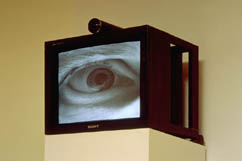
|
| Technical Details: 1 monitor,
computer, dedicated software |
|
Although we often do not realise it, our daily actions are being monitored by hidden cameras, closed video circuits and other surveillance equipment; whether we are at the bank, at an airport, in a museum or a supermarket, our presence is nearly always being registered and checked upon as if we were all potential criminals.
The dream of the technological society in which we exercise 'super'vision over our environment is at the same time a nightmare in which the machinery observes us and spies on us. The question is, in fact, what is the all-seeing video eye trying to unearth, and in service to whom? Who or what is being protected? To a certain extent, our monitoring machines also reflect our glance, and so, ironically, we are trying to escape from our own self-designed 'evil' eye, which at the same time seems to lead a life of its own and appears to be controlled by an unknown quantity.
Big Brother is watching you. He usually spies on you in secret, but the interactive installation I/Eye overtly leers at you and other passers-by. I/Eye is a giant eye which completely fills the screen of a video monitor. It not only looks at you, it follows you and moves with you. Initially you think you are the viewer, the one who has the initiative in this looking game, but then you discover that you are being watched as well. For I/Eye, Spinhoven filmed his own eye in a great many different positions, which, by means of a computer programme, respond to the momentary and 'real life' shots of the viewer. Eye-to-eye with I/Eye, you bodily experience what it feels like to be observed and followed, almost like a thing. An ambiguous experience, to say the least.
But there is an even more specific issue - which is either more or less conspicuous depending on where you are and the context in which I/Eye manifests itself: this is also about your role as an art viewer, which has accustomed you to besieging and conquering the work of art with your interpretive, classifying and aestheticizing glance. With I/Eye, art takes its revenge and stares back relentlessly, as if it is revolting against its passive, subservient position as a posed exhibition object. The glance of the victimized viewer is undermined by the shameless gaze of the work of art, which, against all convention, is itself trying to master the art of observing and reverses the familiar roles.
I/Eye lays bare a dark side of technological and telematic society, and at the same time forces the observer to look at art and him/herself with different eyes.
Jorinde Seijdel
|
|
